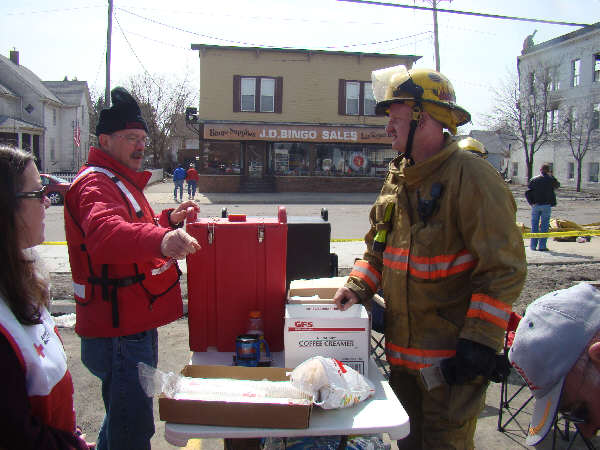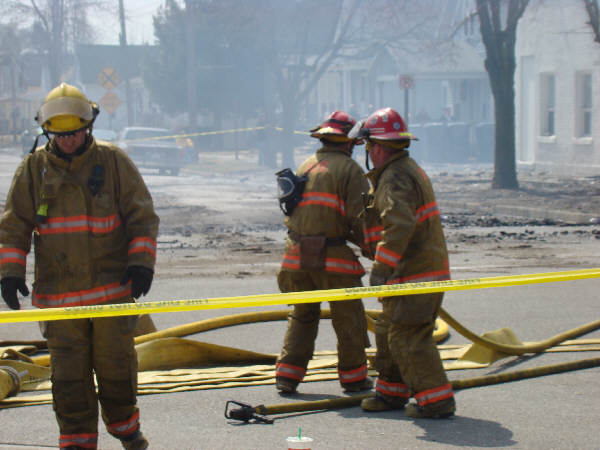Paid On-Call Firefighter Plan Highlights City Finance/Policy Meeting Monday
|
||||||||||
| Printer Friendly Story View |

Local Bay City Firefighters (Above and Below) in action earlier this month during the Manor House Fire in Bay City's South End

City officials and commissioners will handle a "hot" topic Monday night at the Finance and Policy meeting.
Paid on-call firefighters is the issue that will undoubtedly raise the heat in Room 317 at City Hall as the commission chambers will be used by the International Joint Commission for a public meeting on the Upper Great Lakes Study.
According to City Manager Robert V. Belleman, the 6 p.m. meeting will likely run three hours as the proposed 2009 budget for the fire department is discussed on the topic "operational restructuring with loss of personnel."
Paid on-call firefighters typically receive $8-12 per hour, according to reports from other communities with that system.
The Bay City Professional Fire Fighters Local 116 took out a 3 column by 1- 1/2 inch full colore display ad in the Bay City Times business section on Sunday, stating: "Support Your Bay City Fire Fighters - We're here for you 24/7." The ad also referenced functions of the department "Fire Fighting, Rescue, Emergency Medical Response." It urged readers to "Learn More at www.iafflocal116.org," and noted the ad was paid for by the Bay City Professional Fire Fighters IAFF (International Association of Fire Fighters) Local 116.
On the Fire Fighters website is posed a draft copy of the City of Bay City Fire Location Study with the notation "obtained by Freedom of Information Request." The study, prepared by RW Management Group, Inc., of Menasha, Wisconsin, states the city asked the consultants for an "assessment as to the impact of a reduction of 7-9 firefighters."
RW does not recommend a reduction in fire personnel and advises the city to continue to operate four engine trucks and one ladder truck, based on the ISO rating, standards, current response time, housing density and age, and NFPA standards requiring a minimum of initial responders to structure fires.
"It remains uncertain as to whether or not any neighboring communities can provide the support necessary through mutual aid," the consultants said in their report.
The report states the city has population of approximately 36,000 and covers an area of 11.7 square miles with four draw bridges. the fire department currently has 55 members with one chief, one training officer, one fire marshal, one fire prevention officer and 51 members assigned to fire suppression. The department operates four fire stations, each with an engine company, and a ladder truck at the headquarters station. The current ISO (Insurance Services Office) rating is 3 on a scale of 10, less that minimum protection.
Bay City fire fighters responded to 3,620 fire-rescue incidents in 2006, EMS calls accounting for 2,521 incidents or 70 percent of the total. The number of fires was 145, or 3.6 percent of the total. the department has experienced a 25 percent decrease in fire suppression calls since 1996 and a 33 percent increase in EMS calls over 10 years.
Cities across Michigan and the nation are struggling to maintain firefighter staffing levels, with some like Troy, Michigan, with a population of 85,000 turning to a volunteer force of 180 with 14 full time professionals.
A survey shows 83 percent of Troy residents and 81 percent of business owners feel "very satisfied" with the volunteer-based service.
Others, like Garden City, Michigan, with population of 30,000, has 20 cross-trained firefighter/paramedics.
Taylor, population 63,788, has 61 firefighters, down from 70 in 2000. Taylor has about 8,000 runs a year, 80 percent of them medically-related. Voters in Taylor are being asked to approve a city charter provision for minimum fire department staffing.
Firefighters organizations in some cities are asking voters to amend city charters to require minimum staffing levels under the National Fire Protection Association Code 1710-Standard for Organization and Deployment of Fire Suppression Operations, Emergency Medical Operations, and Special Operations to the Public by Career Fire Departments.
This standard involves staffing of career fire departments. In this code, the NFPA has used scientific evidence, past history and first hand experience to establish the minimum number of personnel required to safely and effectively operate on a fire scene.
NFPA 1710 guidelines say that a first arriving company must consist of 4 fire fighters and arrive within 4 minutes of the initial 911 call. For an initial full alarm assignment (any structure fire) minimum personnel on scene should consist of 15-17 fire fighters arriving on scene within 8 minutes of the initial 911 call.
A study by the International City Managers Association (ICMA)has concluded that under-staffing of fire departments is a nationwide problem. The ICMA has conducted studies to determine the effectiveness of fire companies based on staffing.
The following information was published the trade magazine Managing Fire Services, 2nd edition. This international organization of city leaders recognizes the importance of a properly staffed fire department. This publication included this information:
1. Fire suppression operations have three basic functions: (1) rescue; (2) work involving ladder, forcible entry, and ventilation; and (3) the application of water. To raise ladders, ventilate, search, and rescue simultaneously takes quick action by at least four and often eight or more firefighters, each under the supervision of an officer.
2. If about 16 trained firefighters are not operating at the scene of a working fire within the critical time period, then dollar loss and injuries are significantly increased as the fire spreads.
3. As firefighting tactics were conducted and judged for effectiveness;
5 -person companies were 100% effective.
4 -person companies were 65% effective.
3 -person companies were 38% effective.
NFPA recommends four person companies.
Meanwhile, suburban Detroit communities have joined together in the Michigan Suburbs Alliance to collaborate on public services by sharing costs, equipment, knowledge and personnel.###
| Printer Friendly Story View |
|
|

Dave Rogers |
|
|
|
Printer-Friendly Story View
0200 Nd: 04-20-2024 d 4 cpr 0
12/31/2020 P3v3-0200-Ad.cfm
SPONSORED LINKS
12/31/2020 drop ads P3v3-0200-Ad.cfm


